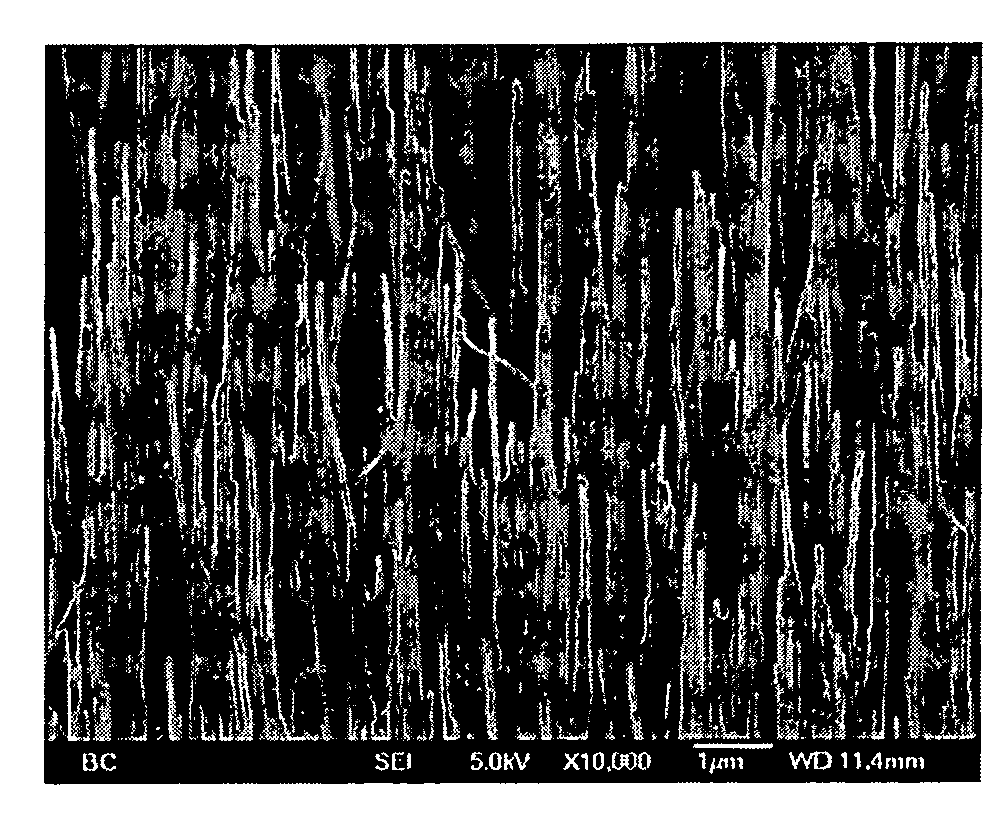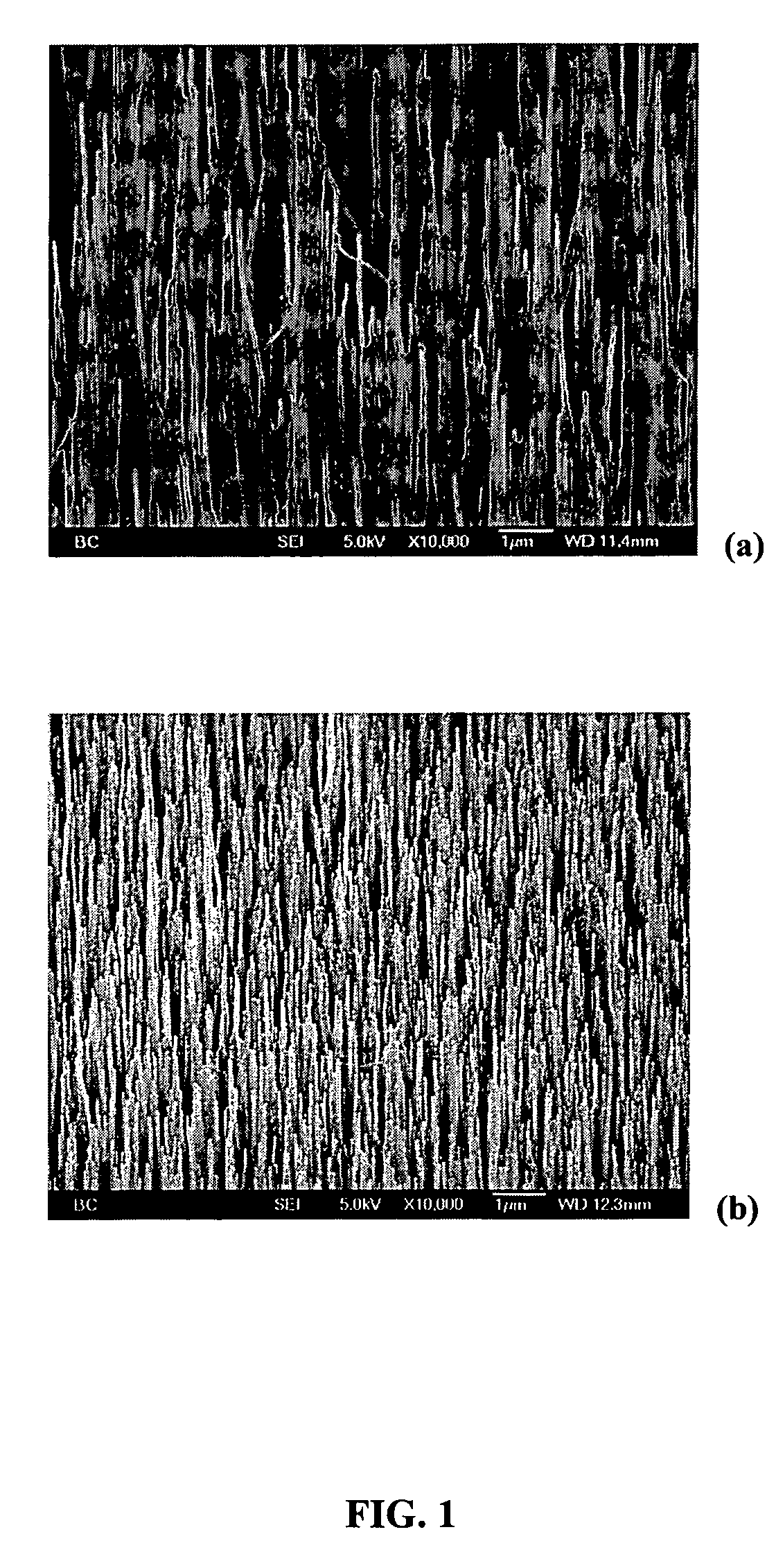Coated carbon nanotube array electrodes
a carbon nanotube and array electrode technology, applied in the direction of surface reaction electrolytic coating, nanoinformatics, solid-state devices, etc., can solve the problems of producing defects that produce electrically-insulating domains on the substrate surface, and achieve the effect of enhancing electrical conductivity
- Summary
- Abstract
- Description
- Claims
- Application Information
AI Technical Summary
Benefits of technology
Problems solved by technology
Method used
Image
Examples
example 1
Synthesis of Well-aligned Carbon Nanotubes (CNTS)
[0057]Well-aligned carbon nanotubes were obtained by methods disclosed in the art (see Z. F. Ren, et al., Science 282 (1998) 1105; Z. P. Huang et al. Appl. Phys. Lett. 73 (1998) 26; Z. F. Ren, et al., Proceedings of the 13th International Winter School on Electronic Properties of Novel Materials, (1999) 263; Z. F. Ren, et al., Appl. Phys. Lett., 75 (1999) 1086; and Z. F. Ren, et al., Proceedings of the 32nd International Technical Conference of the Society for the Advancement of Materials and Process Engineering (SAMPE), Nov. 5-9, 2000, Boston, USA, pp. 200-204). Titanium (Ti) is used as base substrate upon which a thin nickel (Ni) layer of about 15-25 nm was surface coated by magnetron sputtering to function as a catalyst for CNT growth. The CNTs obtained by this method have tubule diameters ranging from 50-100 nm and tubule lengths of 8-10 μm. Tubule diameter and length is controlled by varying the Ni layer thickness and growth time...
example 2
PPy Deposition and Electrochemical Measurements
[0058]PPy films were deposited on CNT substrates by in-situ polymerization of pyrrole potentiodynamically using a standard three-electrode cell from 17.3 mM pyrrole (Aldrich) and 0.1M LiClO4 (Aldrich, A.C.S reagent) aqueous solutions. A PC4 potentiostat / Galvanostat (Gamary Instruments Inc., Warminster, Pa. 18974) was employed for the synthesis and cyclic voltammetric (CV) measurements of PPy films. Platinum wire was used as the counter electrode, and a saturated calomel electrode (SCE) was used as the reference electrode. Prior to PPy deposition, the CNT substrates were pretreated in 15% wt. HNO3 aqueous solution for 30 minutes to remove non-adherent metallic Ni catalyst particles and also to increase electrochemical activity of the surface of the CNTs in water and aqueous solutions. After PPy deposition, the substrates were soaked in double distilled water for 30 minutes to remove unreacted pyrrole monomer. Redox processes of the PPy-c...
example 3
Characteristics of PPy Films Polymerized on CNT Substrates
Film Thickness
[0059]PPy coatings obtained on CNT substrates via the in-situ polymerization methods provides highly uniform films on the surface of individual CNT tubules. A typical film thickness of about 90 nm is obtained by passing a charge of about 1308.6 mC / cm2 on the outer surface of individual tubules. In comparison, film thickness of about 1.1 μm and about 1.5 μm, are obtained upon passing a charge of about 645 mC / cm2 and about 933 mC / cm2 on Ti and Pt surfaces respectively.
Film Morphology
[0060]PPy film morphologies are dependant on film thickness film formation charge (Qfilm). A small film formation charge (Qfilm) results in a thin PPy coating (about 8 to 10 nm), coated CNT substrates that are not free-standing. The CNT tubules form bundles as a result of surface tension. With increase in Qfilm, the thickness of the PPy films on the tubule surface increases to about 90 nm, providing mechanically strong, coated tubules ...
PUM
| Property | Measurement | Unit |
|---|---|---|
| length | aaaaa | aaaaa |
| tubule diameter | aaaaa | aaaaa |
| tubule diameter | aaaaa | aaaaa |
Abstract
Description
Claims
Application Information
 Login to View More
Login to View More - R&D
- Intellectual Property
- Life Sciences
- Materials
- Tech Scout
- Unparalleled Data Quality
- Higher Quality Content
- 60% Fewer Hallucinations
Browse by: Latest US Patents, China's latest patents, Technical Efficacy Thesaurus, Application Domain, Technology Topic, Popular Technical Reports.
© 2025 PatSnap. All rights reserved.Legal|Privacy policy|Modern Slavery Act Transparency Statement|Sitemap|About US| Contact US: help@patsnap.com



